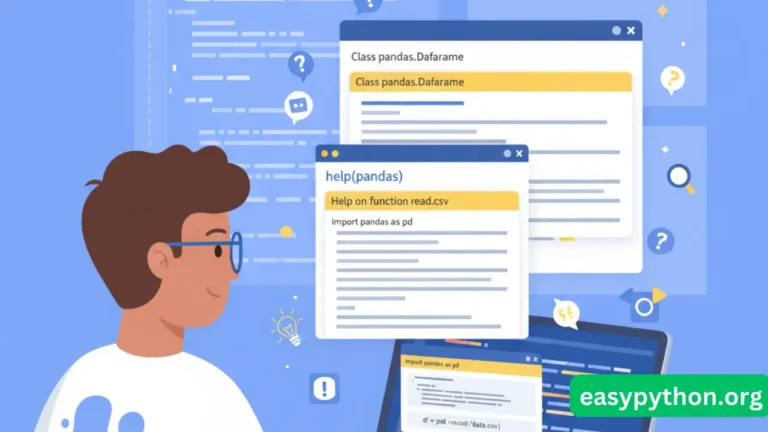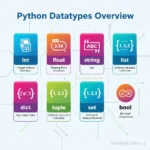So, picture this: you’re sitting in front of your computer, coffee gone cold ☕, staring at your Python code that looks more like hieroglyphics than logic. You type a line, hit run… BOOM – error! Python gives you an error message that might as well be written in alien language.
And what do most beginners do?
👉 Copy-paste the error into Google or ChatGPT.
👉 Pray to StackOverflow gods.
👉 Or text a friend at 2 AM: “brooo why isn’t this working 😭”
But here’s the spicy truth: Python already comes with a built-in help utility that can save you from all that drama. No more googling “What does str.strip() even do??”
Let’s unpack the Python help function — your personal debugging buddy, teacher, and sometimes a life-saver when you don’t want to feel like a total noob.
What is the Python help() Function?
The help() function in Python is basically like that overly-enthusiastic teacher who knows everything and won’t stop talking until you understand.
- It shows you documentation.
- Explains what functions, modules, or objects do.
- And yes, it works right inside your terminal.
Think of it as a built-in encyclopedia 📚 that lives in your Python environment.
Example:
help(str)This will give you all the juicy details about Python strings — methods, descriptions, and usage examples. Basically, the cheat sheet you didn’t know you had.
How to Use the Python Help Utility
Alright, let’s get practical.
Using help() Without Arguments
Just type:
help()Boom! You enter interactive help mode. It’s like Python’s very own secret chamber. You can explore topics, modules, or functions from here. Type quit when you’re done.
Getting Help on Objects or Modules
help(len)
help(list)
help(math)Want to know why your list slicing failed? Or what the heck the math module offers? Just throw it into help().
Help on Custom Functions
If you write your own functions and add docstrings, help() will display them.
def greet(name):
"""This function greets the user by name."""
return f"Hello, {name}!"
help(greet)This is why writing docstrings isn’t just a boring tradition — it makes your code future-you friendly.
👉 Pro tip: If docstrings feel confusing, check out my guide to Python variables where I explain beginner stuff in simple terms.
Why Python Help Utility?
Good question. Why not just stick to StackOverflow?
Here’s why:
- Instant access → No internet, no problem.
- Context-aware → Works inside your code environment.
- Beginner-friendly → It won’t roast you for asking dumb questions (unlike some forums 😅).
It’s especially useful when learning the basics — like data types or collections.
Common Mistakes Beginners Make with help() 🙃
- Not using it at all — bro, stop suffering in silence.
- Forgetting docstrings — write them, or future-you will hate you.
- Confusing help() with dir() —
dir()lists attributes,help()explains them. Big difference. - Closing the terminal too early — then googling like a headless chicken.
help() vs dir() vs inspect
If Python was the Marvel universe, these three would be the Avengers of introspection:
- help() → The teacher who explains everything.
- dir() → The librarian who gives you a list of available books but doesn’t explain.
- inspect → The detective 🕵️♂️ who digs deeper into code objects.
Pro coders often combine these. For example:
import inspect
print(inspect.getsource(greet))Now you’re literally spying on your code. Creepy but useful.
Real-Life Example: Debugging Like a Pro
Let’s say you forgot how to use sorted(). Instead of searching random blogs, try:
help(sorted)Python politely explains:
- You can sort lists, tuples, etc.
- You can use
key=andreverse=.
No fluff, no ads, no cookie banners asking “accept all?”.
FAQs about Python Help Function
Can I use help() in IDLE?
Yep, totally. In fact, if you’re using Python IDLE, help() works like magic.
Does help() work offline?
Yes. No Wi-Fi? No problem. (Good luck if you were relying on YouTube tutorials tho 😅).
How is help() related to docstrings?
Whatever you write in docstrings is what help() shows. Basically, your own words will haunt you later.
Resources Worth Bookmarking
And of course, don’t forget to explore my internal guides:
Final Thoughts
The Python help function is like that one friend who always has the answers (but doesn’t make you feel dumb for asking). It’s fast, reliable, and already sitting inside your Python environment waiting to be used.
So next time you’re stuck, don’t panic, don’t spam Google. Just ask Python itself:
help(your_problem_here)Your debugging journey will get smoother, your learning faster, and your confidence higher. 🚀




